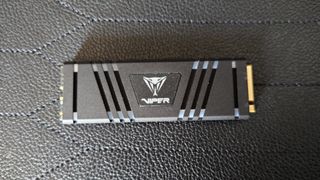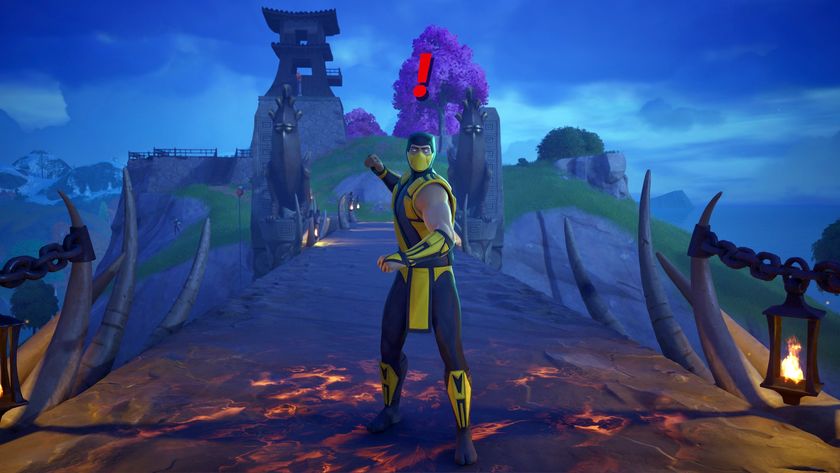12DOVE Verdict
The Viper VPR400 is an attractive NVMe SSD with its world's first RGB lighting, there's no getting around that, but it doesn't perform well enough to justify its high price tag.
Pros
- +
Gorgeous RGB lighting
- +
Compatible with lots of software
- +
The first of its kind
Cons
- -
Outclassed by most other Gen 4.0 drives
- -
You'll need decent clearing on your board
- -
Expensive for the speeds on offer
Why you can trust 12DOVE
The Patriot Viper VPR400 is the world's first RGB-enabled Gen 4.0 SSD, there's definitely some merit in trying something different in the PC hardware space. However, with poor overall sequential performance and a high price tag, this innovative model doesn't quite make the cut as one of the best SSDs for gaming despite all the flashiness it brings to the table.
Design and Features
The Patriot Viper VPR400 is the world's first Gen 4.0 NVMe SSD with RGB lighting built right into the heatsink, and that's certainly the main selling point with the brand's new drive. It's all about aesthetics as far as this storage stick is concerned, and as expected, the Patriot Viper VPR400 is a thing of beauty when in action.
Once installed into your motherboard's M.2 port, the Patriot Viper VPR400 will glow in a vast array of colors. RGB is nothing new for many gaming PC components, especially graphics cards and RAM, but having this feature included with storage is sure to impress those wanting the flashiest systems that money can build. I can praise this drive for being natively compatible with many different RGB software from major manufacturers as well, including AS Rock Polychrome Sync, Asus Aura Sync, Gigabyte RGB Fusion 2.0, and MSI Mystic Light Sync. No Corsair iCue support, though, but OpenRGB will have you covered here anyway. It's safe to say that many different motherboards armed with RGB controllers will be catered to here, and that's worth commending.

The aluminum housing is sturdy and has a decent amount of weight to it as well, but it is a little bit on the thicker side. Our GamesRadar test system has a total of 4x Gen 4.0 NVMe M.2 ports, with three of them living under a standard heatshield. In order to use this drive, I had to remove this from our Z690 board, and your mileage may vary in this respect as well. I can't lie though, it is incredibly satisfying to see our water cooling pump and radiator fans, SSD, and LED-infused case lit up like a firework.
On the technical front, the Patriot Viper VPR400 is powered by the Innogrit IG5220 controller, and we've seen this fairly inexpensive option in several more affordable Gen 4.0 drives in recent memory. While serviceable, you're certainly not going to reach the blazing speeds afforded by the likes of the Phison E18, which you'll find in top performers such as the Kingston Fury Renegade.

Performance
The Patriot Viper VPR400 promises sequential performance of up to 4,600 MB/s reads and 4,400 MB/s writes. While a significant step up above what's possible through the previous generation Gen 3.0 drives, which capped out at around 3,500 MB/s respectively, for the asking price these kinds of numbers are quite pathetic in all honesty. Your standard middle-of-the-road can do around 5,500 MB/s respectively, so these rates are quite disappointing all around.
Patriot's website itself claims that the Viper VPR400 is built for "high performance, unbelieve speed, and intense power" and this is a statement that I fundamentally disagree with. In my testing, I found that this model did in fact slightly exceed these humbling figures, with Crystal Disk Mark recording 5,174 MB/s and 4,785 MB/s respectively. Anvil Pro clocked in with an overall score of 21,329.04, which is in line with many other Gen 4.0 drives.
In-game performance was solid as expected from any Gen 4.0 drive on the market right now. I didn't notice any particular slow down or any longer loading times than normal with our usual suite of benchmarking games. What's important to remember here is that you're still getting faster speeds than a traditional SATA or older NVMe model, you're just paying one hell of a premium for it.

Should you buy the Patriot Viper VPR400 RGB SSD?
I do not believe that the Patriot Viper VPR400 justifies its $134.99 / £129.99, as even though I was able to clock slightly higher than advertised speeds, this is still far below the average for what you should expect from Gen 4.0 compatibility right now.
The asking price is my biggest problem with this drive, as in the same price range you can pick up the SK hynix Platinum P41, as well as find the far superior Samsung 980 Pro, XPG Gammix S70 Blade, and Sabrent Rocket 4 Plus regularly discounted to this rate as well. All of these drives are pushing 7,000 MB/s sequential or more.
As with anything that's the first of its kind though, there are going to be beta testers. Simply put, if you want to get your hands on the world's first Gen 4.0 RGB SSD then the Patriot Viper VPR400 is your only option. I cannot recommend it for the poor price-to-performance ratio, but I cannot speak for everyone, especially when we're only a few months away from the launch of Gen 5.0 drives that will absolutely smoke this one.
How we tested the Patriot Viper VPR400
I ran industry-standard benchmarking tests, CrystalDiskMark and Anvil Pro, from our official GamesRadar test system. I also tested the loading times in Shadow of the Tomb Raider and Metro Exodus, two of our well-versed benchmarking titles.

Aleksha McLoughlin served as the Hardware Editor for GamesRadar from June 2021 until August 2022. Her main area of expertise was the PC gaming platform, which comprised buying guides, features, reviews, and news coverage on components and prebuilt machines. She was also responsible for gaming chairs and storage. She now works on a freelance basis while studying to become a university lecturer specializing in English for foreign territories. Prior to joining GamesRadar, she wrote for the likes of Expert Reviews, The Rory Peck Trust, No Clean Singing, Vinyl Chapters, and Tech Spark while also working with the BBC.













